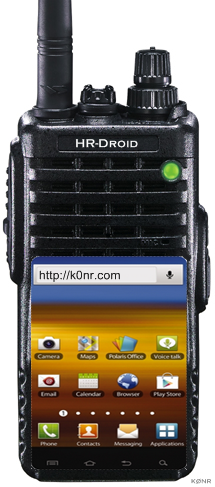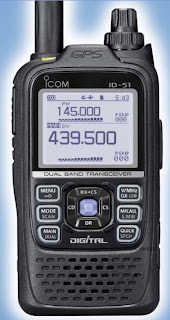Posts Tagged ‘D-Star’
 Show Notes @#100
Show Notes @#100
Introduction:
- Promo: Listen to the Linux Basement Podcast.
- Happy Birthday, Richard!
- Yes, folks, it’s episode 100 of Linux in the Ham Shack. We’re now eligible for syndication!

Topics:
- In celebration of our 100th episode, several of our listeners in the chat room call in and participate in a roundtable discussion. Participants include Harrison (VE2HKW), Brian (K5BPC), and Jon (KT4KB). Unfortunately, noise on Jon’s connection prevented him from staying on the line.
- We received voice messages from listeners Michelle, Joy, Rich (KD0RG), Doug (N6LMX), Nick, Jon, “Major J”, and Harrison (VE2HKW).
- Feedback from Matt (KD8SZG), who asks which would be a better choice for a new HF user: a used IC-7000 or new FT-857D. The consensus is to choose the new FT-857D.
- Jon, KT4KB, asks how Russ and Richard met.
- Richard makes a shocking announcement!
- We have a short discussion of FreeDV vs. D-STAR, followed by a brief discussion of various Linux distributions.
- Richard makes a few final comments.
Contact Info:
- Contact Richard at [email protected], Russ at [email protected], or both at the same time at [email protected].
- Listen to the live stream every other Tuesday at 8:00pm Central time. Check the LHS web site for dates.
- Leave us a voice mail at 1-909-LHS-SHOW (1-909-547-7469), or record an introduction to the podcast.
- Sign up for the LHS mailing list.
- Sign up for the MAGNetcon mailing list.
- LHS merchandise is available at the Merch link on Web site. Check out the Badgerwear or buy one of the other LHS-branded items at PrintFection.com/lhs or Cafe Press. Thanks!
- Thanks to Dave from Gamma Leonis for the theme music.
Music:
- Gun Slinger by Daniel Worth.
 Digital voice on HF
Digital voice on HF
I was going to title this post “D-Star’s nemesis” but I thought that would be too provocative and premature! But the much talked-about Codec2 open source voice codec has just surfaced in usable form, in the shape of an easy to use bit of software called FreeDV.
 |
| FreeDV running on Windows |
FreeDV is available for Linux, Windows and Mac. I installed the Windows version, which is just a matter of extracting the files from a zip archive into a folder.
If you’re set up to run digital modes on HF then you’re half way there already. FreeDV uses the same sound card as your digimode software and the same audio levels. As with PSK31 you just need to make sure you aren’t driving the transmitter into ALC.
You’ll need a second sound card for the receive and transmit audio. Assuming that you aren’t using one sound card for both digimodes and computer sound, this will be the one you use for Windows noises. On my shack PC that’s one of those el cheapo eBay USB sound card dongles. You’ll also need a microphone or a computer headset.
There’s no VOX (perhaps that will come in a later version of FreeDV) so you have to click a button to toggle PTT. Before you can do that you need to set up PTT using a com port. In my case the same serial port used for CAT control and updating the firmware of my K3 was used. The rig went straight into transmit until I ticked the RTS +V check box.
The main challenge is finding other people who are using FreeDV. At the moment the frequency 14.236MHz on 20m seems to be the only calling frequency. It would be nice to have some centres of activity on other bands, but no doubt that will come in due course. There’s a Digital Voice Google Group which will probably become the meeting place for FreeDV users.
A FreeDV transmission is 1.1kHz wide, less than half of the bandwidth of an SSB signal. The audio is best described as telephone quality. It’s a bit boxy, but there is an equalizer called “Filter” in the software that can be used to brighten up both the transmit and receive audio. A nice feature of the software is a button that lets you instantly switch between analogue and digital so you can easily make comparisons. I wish I could include a clip of the audio recorded off air but I couldn’t figure out how to do it.
Right now I’m sitting on 14.236MHz waiting for someone else to come on the frequency. Hopefully as the word gets out more people will get on the air with FreeDV and contacts will be easier to come by.
 Show Notes #096
Show Notes #096
Introduction:
- Welcome to another edition of the Super Happy Crappy Hour!
Announcements:
- The Black Sparrow Media mobile app is again hosted thanks to listener donations. Visit the BSM website to download the app and enjoy all of the BSM affiliated shows.
- CafeNinja and the Tin Foil Hat Show have joined the Black Sparrow Media network.
- If you’d like to participate in the chat room, point your IRC client at the irc.freenode.net server, and join the #lhspodcast channel.
- You can listen to the live show by pointing your media player (VLC, Totem, or whatever) to http://stream.blacksparrow.net:8008/lhslive.
- Our live recording night will be moving to Wednesday evenings (CST) beginning with Episode 97, scheduled for December 12th, 2012.
- Welcome Gnorman to the LHS staff.
Topics:
- TLF Contest Logger.
- Our hosts then embark on several digressions about Gnorman, Lua, and other podcasters.
Feedback:
- Torsten, DL1THM, sends an email describing his use of a Raspberry Pi as an APRS digi using aprx software and as a D-Star repeater using a DV-RPTR board. Thanks, Torsten.
- Greg responded to episode 94 about uses for the Raspberry Pi, including a media PC with Raspbmc and perhaps as a weather station. Thanks, Greg.
- Russ and Richard also talk about D-Star stuff, and D-RATS. (D-RATS has been mentioned in LHS episodes 17, 32, 56, 71 and 90.)
- Comment from the Web site from Leif, KC8RWR, in response to episode 91 where Russ rants about the lack of speakers in the head units of mobile radios. Thanks, Leif.
- Fred, DH5FS, sent a suggestion to consider TLF as a Linux contest logger. Thanks, Fred. Your email inspired tonight’s topic.
- Bill, KJ4KNI, on Facebook expressed his appreciation for help getting Linux Mint 13 with the MATE desktop running on his main computer. He also provides several reasons a ham might wish to use RG6 (75 ohm coax) in radio applications. Thanks, Bill.
Contact Info:
- Contact Richard at [email protected], Russ at [email protected], or both at the same time at [email protected].
- Listen to the live stream every other Tuesday at 8:00pm Central time. Check the LHS web site for dates.
- Leave us a voice mail at 1-909-LHS-SHOW (1-909-547-7469), or record an introduction to the podcast.
- Sign up for the LHS mailing list.
- Sign up for the MAGNetcon mailing list.
- LHS merchandise is available at the Merch link on Web site. Check out the Badgerwear or buy one of the other LHS-branded items at PrintFection.com/lhs or Cafe Press. Thanks!
- Thanks to Dave from Gamma Leonis for the theme music.
Music:
- “Crooked Smile Girl” by Heather Pierson, from her album Make It Mine.
- “Agnostic” by Daniel Bautista from the album 15, courtesy of Jamendo.
 The Android HT
The Android HT
 I’ve been watching all of the innovative work going on in the smartphone and tablet arena and wondering how we could get more of that going in ham radio. To be sure, there are always radio amateurs developing creative technology. Some examples are adaptations of D-STAR, IRLP, improvements on APRS and sound card modulation modes. However, amateur radio is missing a standardized platform for handheld communications. Such a radio platform could open up lots of software innovation in this space.
I’ve been watching all of the innovative work going on in the smartphone and tablet arena and wondering how we could get more of that going in ham radio. To be sure, there are always radio amateurs developing creative technology. Some examples are adaptations of D-STAR, IRLP, improvements on APRS and sound card modulation modes. However, amateur radio is missing a standardized platform for handheld communications. Such a radio platform could open up lots of software innovation in this space.
What I have in mind is a dualband (2M/70cm) handheld transceiver that is built on top of the Android operating system. (Sorry Apple Fan Boys, iOS is a non-starter based on Apple’s walled garden philosophy.) This radio would have some of the hardware features we now take for granted in smartphones: GPS, WiFi, USB, maybe even a camera. I’d also include APRS hardware built-in, similar to the Yaesu VX-8GR or the Kenwood TH-D72A. I’ve hacked together a concept photo shown on the left of this post (click to enlarge). We would probably want to maintain some of the most important direct hardware controls such as PTT, volume and channel select. The rest of the user interface would be done via a touchscreen display, where the power of the Android OS comes into play.
While this hardware configuration is exciting, the real power comes from having a software developers kit (SDK) with a stable Application Programming Interface (API). This would unleash the creativity of all those software-oriented hams out there and a plethora of apps would emerge. There are plenty of ham radio apps available on the Apple and Android platforms…it’s just they are missing the radio as part of the package. An obvious area for innovation would initially be in APRS or maybe D-STAR. We could actually have the equivalent of SMS text messaging on ham radio, backed up via the WiFi connection. (Yeah, this kind of exists already but it is really cumbersome to use due to the braindead menu-driven user interfaces of current radios.) Just think how easy programming the radio would be with a touchscreen approach.
This is the type of product development that requires significant investment, but the technology is readily available. I suppose a garage shop operation could get this done but one of the big radio manufacturers could easily pull this off. Maybe one of those upstarts from China might want to take this on. Whoever does it, just send me $5 per unit and I’ll be happy ![]() .
.
That’s my best idea for this morning. What do you think?
73, Bob K0NR
 Show Notes #090
Show Notes #090
Introduction:
- Join us this episode as our intrepid hosts, Richard and Russ (mad posstcatter!), interview John Hays of NorthWest Digital Radio.
Topics:
- Interview with John Hays (K7VE) from NorthWest Digital Radio.
- John has been a licensed amateur radio operator for 40 years. His wife and all of his children are hams, too!
- A couple years ago John gave a presentation at TAPR, and discussed his wish for a reasonably priced radio for digital communications with just a few connections: antenna, power and Ethernet.
- Bryan Hoyer (now K7UDR) approached John and volunteered to build one. Their collaboration (with Basil Gunn) resulted in NorthWest Digital Radio.
- Their first product will be the UDR56K-4 Universal Digital Radio, planned for availability in early 2013.
- John goes on to discuss the features of their digital radio and some of the design decisions the company made.
- Specifications (subject to change, of course):
- 25W 70cm Transceiver
- 4800 to 56Kbps
- FSK, GMSK, 4FSK
- Open Source Linux Platform — a full Linux-based web server is built-in. It uses the Debian kernel, running on an ARM processor (faster than a Raspberry Pi).
- Web Interface over Ethernet
- 4 USB Host Ports
- Applications:
- The radio can be completely controlled through the web interface or the command line.
- John talks about other potential applications for their radio platform.
- Keep an eye on the website for more information and to sign up for email announcements.
- You may also be interested in John’s blog.
Contact Info:
- Contact Richard at [email protected], Russ at [email protected], or both at the same time at [email protected].
- Listen to the live stream every other Tuesday at 8:00pm Central time. Check the LHS web site for dates.
- Leave us a voice mail at 1-909-LHS-SHOW (1-909-547-7469), or record an introduction to the podcast.
- Sign up for the LHS mailing list.
- Sign up for the MAGNetcon mailing list.
- LHS merchandise is available at the Merch link on Web site. Check out the Badgerwear or buy one of the other LHS-branded items at PrintFection.com/lhs or Cafe Press. Thanks!
- Thanks to Dave from Gamma Leonis for the theme music.
 LHS Episode #090: Purple Hays
LHS Episode #090: Purple Hays
 Here we are at Episode #090, just 10 away from the century mark. Things have been rolling along fairly smoothly, and except for Russ being deathly ill for the last eight days, there’s not even a lot to complain about. In this episode, we have yet another interview. This time it’s with John Hays, K7VE, of Northwest Digital Radio. These guys are producing an entirely new purpose-built radio platform called the UDR56K. This technology promises to be a great advance in the amateur radio arena as well as in the computing arena. It’s a bit of kit that’s going to find a use in almost every radio amateur’s shack. If you want to find out why, please sit down and take a listen to this episode of LHS. We promise you will not be disappointed.
Here we are at Episode #090, just 10 away from the century mark. Things have been rolling along fairly smoothly, and except for Russ being deathly ill for the last eight days, there’s not even a lot to complain about. In this episode, we have yet another interview. This time it’s with John Hays, K7VE, of Northwest Digital Radio. These guys are producing an entirely new purpose-built radio platform called the UDR56K. This technology promises to be a great advance in the amateur radio arena as well as in the computing arena. It’s a bit of kit that’s going to find a use in almost every radio amateur’s shack. If you want to find out why, please sit down and take a listen to this episode of LHS. We promise you will not be disappointed.
73 de The LHS Guys
 Icom launches a new handy
Icom launches a new handy
 |
| Icom ID-51 |
Icom has demonstrated a prototype of its latest dual-band handheld transceiver – the ID-51A. (The European version will be the ID-51E.)
Covering 2m and 70cm, the ID-51 can also receive FM broadcasts and AM short wave radio. It supports D-Star (of course) as well as FM mode, and boasts a large 128×104 pixels display, the largest yet seen on an amateur radio handheld rig.
Like its smaller sibling the UHF-only ID-31, the ID-51A/E has a built-in GPS which can be used for track logging to a micro-SD card. The storage card can also be used to record incoming and outgoing voice traffic. Very useful – not!
Disappointingly though not unexpectedly, this new Icom does not support APRS, though it presumably supports D-Star’s rather lame version, D-PRS.
The ID-51 is being billed as the most technically advanced handheld, though it looks like you will be paying a lot for features – like the GPS and short wave receiver – for which most hams will have little use. I doubt that the large display – never mind the GPS – will do much to extend battery life, though Icom will offer an extended battery pack (at the usual inflated Icom prices no doubt.) However it is nice to see a manufacturer breaking the mould for HT user interfaces which have changed little for the last 20 years.












